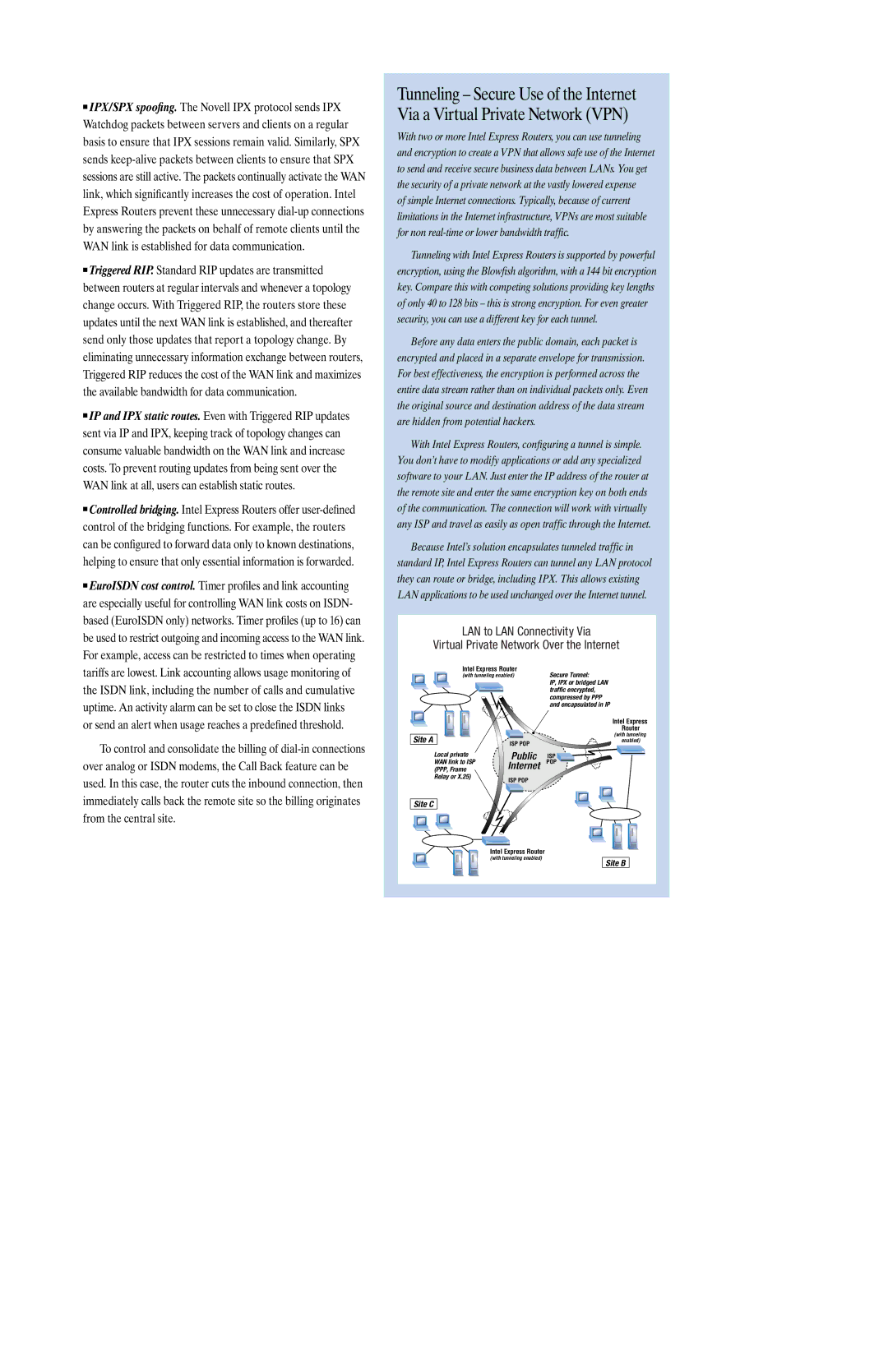
■IPX/SPX spoofing. The Novell IPX protocol sends IPX Watchdog packets between servers and clients on a regular basis to ensure that IPX sessions remain valid. Similarly, SPX sends
■Triggered RIP. Standard RIP updates are transmitted between routers at regular intervals and whenever a topology change occurs. With Triggered RIP, the routers store these updates until the next WAN link is established, and thereafter send only those updates that report a topology change. By eliminating unnecessary information exchange between routers, Triggered RIP reduces the cost of the WAN link and maximizes the available bandwidth for data communication.
■IP and IPX static routes. Even with Triggered RIP updates sent via IP and IPX, keeping track of topology changes can consume valuable bandwidth on the WAN link and increase costs. To prevent routing updates from being sent over the WAN link at all, users can establish static routes.
■Controlled bridging. Intel Express Routers offer
■EuroISDN cost control. Timer profiles and link accounting are especially useful for controlling WAN link costs on ISDN- based (EuroISDN only) networks. Timer profiles (up to 16) can be used to restrict outgoing and incoming access to the WAN link. For example, access can be restricted to times when operating tariffs are lowest. Link accounting allows usage monitoring of the ISDN link, including the number of calls and cumulative uptime. An activity alarm can be set to close the ISDN links or send an alert when usage reaches a predefined threshold.
To control and consolidate the billing of
Tunneling – Secure Use of the Internet Via a Virtual Private Network (VPN)
With two or more Intel Express Routers, you can use tunneling and encryption to create a VPN that allows safe use of the Internet to send and receive secure business data between LANs. You get the security of a private network at the vastly lowered expense
of simple Internet connections. Typically, because of current limitations in the Internet infrastructure, VPNs are most suitable for non
Tunneling with Intel Express Routers is supported by powerful encryption, using the Blowfish algorithm, with a 144 bit encryption key. Compare this with competing solutions providing key lengths of only 40 to 128 bits – this is strong encryption. For even greater security, you can use a different key for each tunnel.
Before any data enters the public domain, each packet is encrypted and placed in a separate envelope for transmission. For best effectiveness, the encryption is performed across the entire data stream rather than on individual packets only. Even the original source and destination address of the data stream are hidden from potential hackers.
With Intel Express Routers, configuring a tunnel is simple. You don’t have to modify applications or add any specialized software to your LAN. Just enter the IP address of the router at the remote site and enter the same encryption key on both ends of the communication. The connection will work with virtually any ISP and travel as easily as open traffic through the Internet.
Because Intel’s solution encapsulates tunneled traffic in standard IP, Intel Express Routers can tunnel any LAN protocol they can route or bridge, including IPX. This allows existing LAN applications to be used unchanged over the Internet tunnel.
LAN to LAN Connectivity Via
Virtual Private Network Over the Internet
Intel Express Router
(with tunneling enabled) | Secure Tunnel: | |
|
| IP, IPX or bridged LAN |
|
| traffic encrypted, |
|
| compressed by PPP |
|
| and encapsulated in IP |
|
| Intel Express |
|
| Router |
Site A |
| (with tunneling |
ISP POP | enabled) | |
|
| |
Local private | Public | ISP |
WAN link to ISP | Internet | POP |
(PPP, Frame |
| |
Relay or X.25) | ISP POP |
|
|
| |
Site C
Intel Express Router
(with tunneling enabled)
Site B
